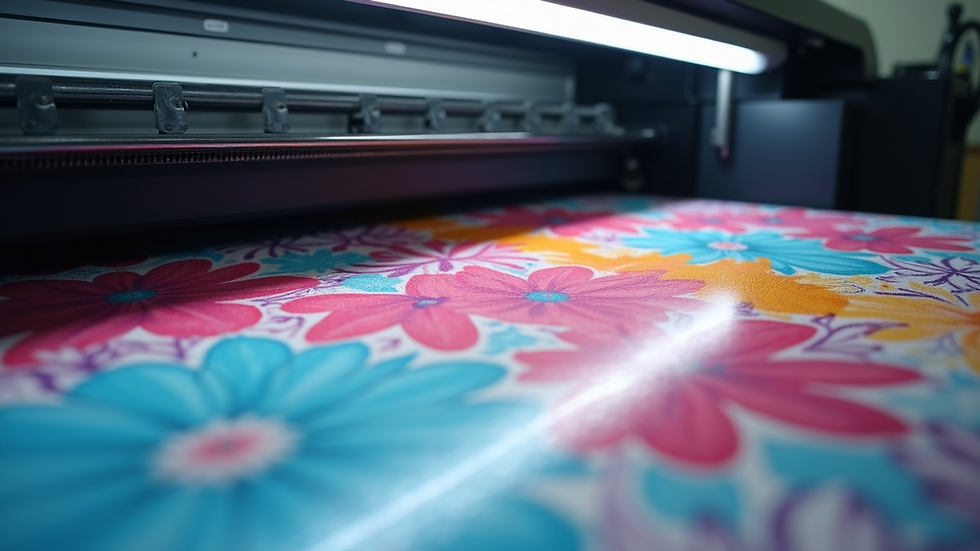Direct-to-Textile Printing for Stunning Results
- BlackW Sign Shop

- Aug 14
- 3 min read
In the world of fabric decoration, digital textile printing services have revolutionised how designs are transferred onto textiles. This innovative method offers vibrant colours, intricate details, and fast turnaround times, making it a favourite for designers, brands, and hobbyists alike. Whether you want to create custom apparel, home décor, or promotional items, digital textile printing opens up endless possibilities.
Exploring Digital Textile Printing Services
Digital textile printing services use advanced inkjet technology to print designs directly onto fabric. Unlike traditional methods such as screen printing, this process allows for high-resolution images with unlimited colour options. The fabric is fed through a printer that applies specialised inks, which are then fixed using heat or steam.
Some key benefits of digital textile printing services include:
Customisation: Print one-off designs or small batches without extra setup costs.
Detail and Colour: Achieve photo-quality prints with gradients and fine lines.
Speed: Faster production times compared to traditional methods.
Eco-friendly: Uses less water and produces less waste.
For example, a fashion designer can quickly prototype new patterns on silk or cotton, while a home décor company can produce limited-edition cushion covers with complex artwork.

How Digital Textile Printing Works
The process begins with preparing the digital artwork. Designers create or scan images using graphic software, ensuring the resolution and colour profiles are suitable for fabric printing. The fabric is then pre-treated to improve ink absorption and durability.
Next, the fabric is loaded into the printer. The printer sprays tiny droplets of ink onto the textile in precise patterns. Depending on the fabric type and ink used, the printed material may require steaming or heat pressing to fix the colours permanently.
Common fabrics used in digital textile printing include:
Cotton
Polyester
Silk
Linen
Blends
Each fabric reacts differently to inks, so testing is essential to achieve the best results. For instance, polyester fabrics often require sublimation inks, which bond with the fibres under heat.

What are the disadvantages of DTG printing?
While digital textile printing offers many advantages, it also has some limitations to consider:
Cost for Large Runs: For very large production runs, traditional screen printing may be more cost-effective.
Fabric Limitations: Some fabrics, especially dark or heavily textured ones, can be challenging to print on digitally.
Durability: Prints may fade faster than screen-printed designs if not properly cared for.
Ink Restrictions: Certain inks may not be suitable for all fabric types or end uses.
Pre-treatment Requirement: Some fabrics need pre-treatment, adding an extra step and cost.
Despite these drawbacks, many businesses find that the flexibility and quality of digital textile printing outweigh the negatives, especially for custom or short-run projects.
Practical Tips for Using Digital Textile Printing Services
To get the most out of digital textile printing, consider the following recommendations:
Choose the Right Fabric: Match your fabric choice with the printing method and ink type for optimal results.
Prepare High-Quality Artwork: Use high-resolution images and correct colour profiles to avoid pixelation or colour shifts.
Test Samples: Always request samples before committing to large orders to check colour accuracy and fabric feel.
Understand Care Instructions: Follow washing and handling guidelines to maintain print longevity.
Work with Experienced Providers: Partner with reputable digital textile printing services that understand your needs and can offer expert advice.
For those interested in exploring options, direct-to-textile printing is a great place to start. They offer a range of fabrics and printing techniques tailored to different projects.

Future Trends in Digital Textile Printing
The future of digital textile printing looks promising with ongoing advancements in technology and materials. Some emerging trends include:
Sustainable Inks and Fabrics: Increased use of eco-friendly inks and organic textiles.
Faster Printing Speeds: New printers capable of higher throughput without sacrificing quality.
Smart Textiles: Integration of printed electronics and sensors into fabrics.
Personalisation at Scale: More brands offering customised products with quick turnaround.
3D Printing on Textiles: Combining 3D printing techniques with fabric printing for unique textures.
These innovations will continue to expand the creative and commercial possibilities of digital textile printing services.
Maximising Your Textile Printing Projects
Whether you are a designer, retailer, or manufacturer, embracing digital textile printing can elevate your product offerings. By understanding the process, benefits, and limitations, you can make informed decisions that save time and money while delivering stunning results.
Remember to:
Communicate clearly with your printing partner.
Keep up with new technologies and materials.
Experiment with different fabrics and designs.
Prioritise quality control at every stage.
With these strategies, your textile printing projects will stand out in a competitive market and delight your customers with vibrant, durable, and customised products.





Comments